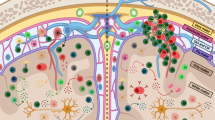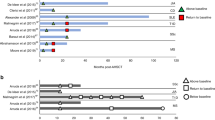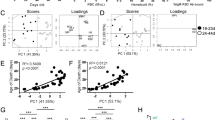Abstract
We have investigated the influence of different hematopoietic growth factors, including granulocyte colony-stimulating factor (G-CSF), stem cell factor (SCF), Flt-3 ligand (Flt-3L) and thrombopoietin (TPO), on the course of relapsing experimental autoimmune encephalomyelitis, a mouse model of multiple sclerosis. Disease course and central nervous system histology were evaluated in all groups. When given after immunization but before either disease onset or during remission, Flt-3L, SCF and G-CSF exacerbated disease severity whereas TPO had no effect compared to non-cytokine-treated controls. When compared to controls, TPO did not exacerbate disease. We conclude that autoimmune disease severity may be affected by hematopoietic growth factors currently being employed in hematopoietic stem cell transplantation of patients with autoimmune disease. The mechanism of their effects remains unknown: it may be related to both T helper (Th) 1/Th2 skewing and/or homing of inflammatory cells to the disease-affected organ.
This is a preview of subscription content, access via your institution
Access options




Similar content being viewed by others
References
Jee Y, Matsumoto Y . Two-step activation of T cells, clonal expansion and subsequent Th1 cytokine production, is essential for the development of clinical autoimmune encephalomyelitis. Eur J Immunol 2001; 31: 1800–1812.
Begolka WS, Vanderlugt SM, Rahbe SM, Miller SD . Differential expression of inflammatory cytokines parallels progression of central nervous system pathology in two clinically distinct models of multiple sclerosis. J Immunol 1998; 161: 4437–4446.
Burt RK, Padilla J, Begolka WS, Dal Canto MC, Miller SD . Effect of disease stage on clinical outcome after syngeneic bone marrow transplantation for relapsing experimental autoimmune encephalomyelitis. Blood 1998; 91: 2609–2616.
van Gelder M, van Bekkum DW . Effective treatment of relapsing experimental autoimmune encephalomyelitis with pseudoautologous bone marrow transplantation. Bone Marrow Transplant 1996; 18: 1029–1034.
Karussis DM, Vourka-Karussis U, Lehmann D, Ovadia H, Mizrachi-Koll R, Ben-Nun A et al. Prevention and reversal of adoptively transferred, chronic relapsing experimental autoimmune encephalomyelitis with a single high dose cytoreductive treatment followed by syngeneic bone marrow transplantation. J Clin Invest 1993; 92: 765–772.
Burt RK, Cohen BA, Russell E, Spero K, Joshi A, Oyama Y et al. Hematopoietic stem cell transplantation for progressive multiple sclerosis: failure of a total body irradiation-based conditioning regimen to prevent disease progression in patients with high disability scores. Blood 2003; 102: 2373–2378.
Burt RK, Cohen B, Rose J, Petersen F, Oyama Y, Stefoski D et al. Non-myeloablative hematopoietic stem cell transplantation for multiple sclerosis. Arch Neurol 2005; 62: 860–864.
Flishie RJA . Cytokines in haemopoietic progenitor mobilization for peripheral blood stem cell transplantation. Curr Pharm Des 2002; 8: 379–394.
Openshaw H, Stuve O, Antel JP, Nash R, Lund BT, Weiner LP et al. Multiple sclerosis flares associated with recombinant granulocytes colony-stimulating factor. Neurology 2000; 54: 2147–2150.
Burt RK, Fassas A, Snowden JA, van Laar JM, Kozak T, Wulffraat NM et al. Collection of hematopoietic stem cells from patients with autoimmune diseases. Bone Marrow Transplant 2001; 28: 1–12.
Young JC, Bruno E, Luens KM, Wu S, Backer M, Murray LJ . Thrombopoietin stimulates megakaryocytopoiesis, myelopoiesis, and expansion of CD34+ progenitor cells from single CD34+Thy-1+Lyn− primitive progenitor cells. Blood 1996; 88: 1619–1631.
Kaushansky K . Thrombopoietin and the hematopoietic stem cell. Ann NY Acad Sci 2005; 1044: 139–141.
Broudy VC . Stem cell factor and hematopoiesis. Blood 1997; 90: 1345–1364.
Murray LJ, Luens KM, Estrada MF, Bruno E, Hoffman R, Cohen RL et al. Thrombopoietin mobilizes CD34+ cell subsets into peripheral blood and expands multilineage progenitors in bone marrow of cancer patients with normal hematopoiesis. Exp Hematol 1998; 26: 207–216.
Burt RK, Slavin S, Burns WH, Marmont AM . Induction of tolerance in autoimmune diseases by hematopoietic stem cell transplantation: getting closer to a cure? Blood 2002; 99: 768–784.
Bluestone JA, Tang Q . How do CD4+CD25+ regulatory T cells control autoimmunity? Curr Opin Immunol 2005; 17: 638–642.
Kohm AP, Carpentier PA, Anger HA, Miller SD . Cutting edge: CD4+CD25+ regulatory cells suppress antigen-specific autoreactive immune responses and central nervous system inflammation during active experimental autoimmune encephalomyelitis. J Immunol 2002; 169: 4712–4716.
Read S, Malmstrom V, Powrie F . Cytotoxic T lymphocyte-associated antigen 4 plays an essential role in the function of CD25+CD4+ regulatory cells that control intestinal inflammation. J Exp Med 2002; 192: 295–302.
Lyman SD, James L, Vanden Bos T, de Vries P, Brasel K, Gliniak B et al. Molecular cloning of a ligand for the flt2/flk-2 tyrosine kinase receptor: a proliferative factor for primitive hematopoietic cells. Cell 1993; 75: 1157–1167.
Hudak S, Hunte B, Culpepper J, Menon S, Hannum C, Thompson-Snipes L et al. FLT3/FLK2 ligand promotes the growth of murine stem cells and the expansion of colony-forming cells and spleen colony-forming units. Blood 1995; 85: 2747–2755.
Brasel K, McKenna HJ, Morrissey PJ, Charrier K, Morris AE, Lee CC et al. Hematologic effects of flt3 ligand in vivo in mice. Blood 1996; 88: 2004–2012.
Robinson S, Mosley RL, Parajuli P, Pisarev V, Sublet J, Ulrich A et al. Comparison of the hematopoietic activity of flt-3 ligand and granulocyte–macrophage colony-stimulating factor acting alone or in combination. J Hematother Stem Cell Res 2000; 9: 711–720.
Maraskovsky E, Brasel K, Teepe M, Roux ER, Lyman SD, Shortman K et al. Dramatic increase in the numbers of functionally mature dendritic cells in Flt3 ligand-treated mice: multiple dendritic cell populations identified. J Exp Med 1996; 184: 1953–1962.
Pulendran B, Banchereau J, Burkeholder S, Kraus E, Guinet E, Chalouni C et al. Flt3-ligand and granulocyte colony-stimulating factor mobilize distinct human dendritic cell subsets in vivo. J Immunol 2000; 165: 566–572.
Wagemaker G, Neelis KJ, Hartong SC, Wognum AW, Thomas GR, Fielder PJ et al. The efficacy of recombinant thrombopoietin in murine and nonhuman primate models for radiation-induced myelosuppression and stem cell transplantation. Stem Cells 1998; 16: 375–386.
Ninos JM, Jefferies LC, Cogle CR, Kerr WG . The thrombopoietin receptor, c-Mpl, is a selective surface marker for human hematopoietic stem cells. J Translat Med 2006; 4: 9; doi:10.1186/1479-5876-4-9.
Ratajczak MZ, Ratajczak J, Machalinski B, Mick R, Gewirtz AM . In vitro and in vivo evidence that ex vivo cytokine priming of donor marrow cells may ameliorate posttransplant thrombocytopenia. Blood 1998; 91: 353–359.
Bojko P, Pawloski D, Stellberg W, Schroder JK, Seeber S . Flt3 ligand and thrombopoietin serum levels during peripheral blood stem mobilization with chemotherapy and recombinant human glycosylated granulocyte colony-stimulating factor (rhu-G-CSF, lenograstim) and after high-dose chemotherapy. Ann Hematol 2002; 81: 522–528.
Gajewski JL, Rondon G, Donato ML, Anderlini P, Korbling M, Ippoliti C et al. Use of thrombopoietin in combination with chemotherapy and granulocyte colony-stimulating factor for peripheral blood progenitor cell mobilization. Biol Blood Marrow Transplant 2002; 8: 550–556.
Willenborg DO, Staykova MA . Cytokines in the pathogenesis and therapy of autoimmune encephalomyelitis and multiple sclerosis. In: Santamaria P (ed) Cytokines and chemokines in autoimmune disease. Eurekah.com and Kluwer Acad/Plenum Publishers: The Netherlands, 2003, pp 97–116.
Espejo C, Penkowa M, Saez-Torres I, Hidalgo J, Garcia A, Montalban X et al. Interferon-γ regulates oxidative stress during experimental autoimmune encephalomyelitis. Exp Neurol 2002; 177: 21–31.
Billiau A, Heremans H, Vandekerckhove F, Dijkmans R, Sobis H, Meulepas E et al. Enhancement of experimental allergic encephalomyelitis in mice by antibodies against IFN-γ. J Immunol 1988; 140: 1506–1510.
Duong TT, St Louis J, Gilbert JJ, Finkelman FD, Strejan GH . Effect of anti-interferon-γ and anti-interleukin-2 monoclonal antibody treatment on the development of an actively and passively induced experimental allergic encephalomyelitis in the SJL/J mouse. J Neuroimmunol 1992; 36: 105–115.
Welte K, Gabrilove J, Bronchud MH, Platzer E, Morstyn G . Filgrastim (r-metHuG-CSF): the first 10 years. Blood 1996; 88: 1907–1929.
Hock BD, Haring LF, Ebbett AM, Patton WN, McKenzie JL . Differential effects of G-CSF mobilization on dendritic cell subsets in normal allogeneic donors and patients undergoing autologous transplantation. Bone Marrow Transplant 2002; 30: 733–740.
Arpinati M, Green CL, Heimfeld S, Heuser JE, Anasetti C . Granulocyte-colony stimulating factor mobilizes T helper 2-inducing dendritic cells. Blood 2000; 95: 2484–2490.
Sloand EM, Kim S, Maciejewski JP, Van Rhee F, Chaudhuri A, Barrett J et al. Pharmacologic doses of granulocyte colony-stimulating factor affect cytokine production by lymphocytes in vitro and in vivo. Blood 2000; 95: 2269–2274.
Pan L, Delmonte Jr J, Jalonen CK, Ferrara JLM . Pretreatment of donor mice with granulocyte colony-stimulating factor polarizes donor T lymphocytes toward type-2 cytokine production and reduces severity of experimental graft-versus-host disease. Blood 1995; 86: 4422–4429.
Xu S, Hoglund M, Venge P . The effect of granulocyte colony-stimulating factor (G-CSF) on the degranulation of secondary granule proteins from human neutrophils in vivo may be indirect. Br J Haematol 1996; 93: 558–568.
Zavala F, Abad S, Ezine S, Taupin V, Masson A, Bach JF . G-CSF therapy of ongoing experimental allergic encephalomyelitis via chemokine- and cytokine-based immune deviation. J Immunol 2002; 168: 2011–2019.
Lock C, Hermans G, Pedotti R, Brendolan A, Schadt E, Garren H et al. Gene-microarray analysis of multiple sclerosis lesions yields new targets validated in autoimmune encephalomyelitis. Nat Med 2002; 8: 500–508.
Schmidt J, Metselaar JM, Gold R . Intravenous liposomal prednisolone downregulates in situ TNF-α production by T-cells in experimental autoimmune encephalomyelitis. J Histochem Cytochem 2003; 51: 1241–1244.
Crockard AD, Boylan MT, Droogan AG, McMillan SA, Hawkins SA . Methylprednisolone-induced neutrophil leukocytosis down-modulation of neutrophil L-selectin and Mac-1 expression and induction of granulocyte-colony stimulating factor. Int J Clin Lab Res 1998; 28: 110–115.
Larochelle A, Krouse A, Metzger M, Orlic D, Donahue RE, Fricker S et al. AMD3100 mobilizes hematopoietic stem cells with long-term repopulating capacity in nonhuman primates. Blood 2006; 107: 3772–3778.
Acknowledgements
We thank Dr Stephen M Shinall for critical review of this manuscript.
Author information
Authors and Affiliations
Corresponding author
Rights and permissions
About this article
Cite this article
Verda, L., Luo, K., Kim, DA. et al. Effect of hematopoietic growth factors on severity of experimental autoimmune encephalomyelitis. Bone Marrow Transplant 38, 453–460 (2006). https://doi.org/10.1038/sj.bmt.1705473
Received:
Revised:
Accepted:
Published:
Issue Date:
DOI: https://doi.org/10.1038/sj.bmt.1705473



